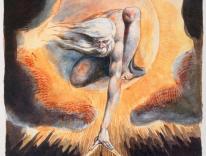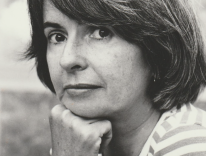In the twenty-first century there remains little doubt that Eastern philosophy and religion have impressed themselves deeply on the consciousness of Western artists. It is a global world, after all, and anyone who knows the work of composer John Cage, installation artist Robert Irwin, painter Ad Reinhardt, or musician and performance artist Laurie Anderson will not be surprised to read of their various immersions in Buddhism. In Smile of the Buddha, Jacquelynn Baas explores the ways in which these and other modern and contemporary artists are indebted to the insights of the Buddha. Finding a connection to the Buddha comes easily to contemporary artists-not simply because the Buddha’s smile is an original piece of performance art, as scholar and Buddhist layman Robert Thurman astutely points out in his foreward, but also because the Buddha’s search for enlightenment is a potent metaphor for the modern artist’s search to pass beyond a mere reproduction of reality toward the comprehension of a greater truth.
Unlike Christianity, Judaism, and Islam, Buddhism is not a revealed religion, as Baas notes in her excellent introduction, but a philosophy of living, “realized from within.” It traces its origins back five centuries before Christ to India, where Siddhartha Gautama left his privileged life to seek an answer to the suffering he witnessed in the world. After years of deprivation, he found the answer in meditation under the Bodhi tree, and in the joy of that awakening, he smiled. (“Buddha” means “the enlightened or awakened one.”) Emulating Buddha, generations of monks spread the message from India to China, Tibet, Korea, Japan, and Southeast Asia, engendering the various forms of Buddhism that exist today. Marco Polo recorded the first encounter between Buddhism and the West in the thirteenth century, but only in our time has the religion gained a significant following worldwide.
Smile of the Buddha includes twenty essays, organized chronologically, on artists ranging from the French Impressionist Claude Monet to the American postmodernist Richard Tuttle. The first section of the book, “The Infinite Moment,” surveys Monet, Van Gogh, Gauguin, and Odilon Redon. While the latter three have all been discussed in the context of late nineteenth-century French spiritualism, and their connection to Buddhist ideas is thus not surprising, Monet is not usually discussed in such terms, and Baas’s reading of his work is fresh and well argued. Art historians have made a case for the influence of Japanese art on Monet and his contemporaries, but as far as I know, Baas is the first to move beyond simple visual analysis or tracing of sources to credit Buddhist thought as an influence on Monet’s process. It is an important insight.
In the second section of the book, “Other Dimensions,” Baas tackles early twentieth-century modernists Wassily Kandinsky and Constantin Brancusi, along with the American Georgia O’Keefe. But her most significant subject is Marcel Duchamp, the Dada maverick who inspired a full-fledged revolution in visual art that continues today. Born in France, Duchamp came to the United States to escape World War I and quickly made a name for himself with Nude Descending a Staircase, his notorious entry in the groundbreaking 1913 New York Armory exhibition.
Duchamp was a pivotal presence in American art. As the creator of the “ready-made,” the found object that became a work of art simply by virtue of a shift in context, he opened a door to conceptual and performance-based art. He was a master of the outrageous, whether editing a short-lived art magazine called Blind Man, exhibiting a urinal in a New York art show, or dressing up as his female alter-ego, Rrose Sélavy (the double R mimicked, in French, the pronunciation of “eros”) in a 1921 series of photographs by Man Ray. Baas’s suggestion that many of Duchamp’s most mysterious acts can be traced to Buddhist precepts is alluring, albeit hard to prove. One of the artist’s most famous works, Bicycle Wheel, was a so-called assisted ready-made, involving the slight alteration of two commonplace objects-a bicycle wheel mounted on a stool. It was an object that Duchamp kept in his studio, and Baas insightfully compares it to a dharma wheel, suggesting it was a meditation device.
“The Space of Art” brings us to the mid-twentieth century with essays discerning Eastern influences in the work of the Japanese-American sculptor, Isamu Noguchi; the French conceptualist, Ives Klein; and the American painters Ad Reinhardt and (less convincingly, to my mind) Jasper Johns. Baas devotes a felicitously titled section, “The Sound of the Mind,” to John Cage and the artists associated with him. Cage was a dominant force in much of the experimental music and visual and performance art of the 1960s and ’70s, and as the composer himself made clear, his immersion in Buddhism was complete. His methods of composition-most famously, using the I Ching and other chance-derived systems to write music, perform, lecture, and make visual art-led a group of like-minded individuals to blur the boundaries between theater, music, dance, and the visual arts. An emphasis on transcendence and change led performance artists such as Yoko Ono, Nam June Paik, and Laurie Anderson to create situations that forced their audiences to reconfigure their thoughts, Baas argues, much as Zen koans push a student toward insight.
Finally, in “Light and Insight,” Baas assesses the work of Americans Agnes Martin, Robert Irwin, Vija Celmins, and Richard Tuttle, all of whom share a desire, Baas observes, to “nudge us to experience ourselves in the world in all of its presence and fullness and in all of its beauty.” Celmins, known for representing aspects of the physical world with hyper-realistic intensity (her best-known images are probably her photographic-looking graphite drawings of the surface of the ocean), seems a surprising addition in this group of abstract minimalists, but Baas is convincing in her articulation of Celmin’s process as “a sustained practice of focus on the phenomenal world”-a way of opening the mind and letting go of the ego.
Filled with such welcome insights, Smile of the Buddha makes for an important addition to contemporary art writing. For those readers who already value the meditative qualities of contemporary art, there is much to savor in these individual spiritual journeys. Early in her book Baas points out that Buddhism, like art itself, “challenges thinking as a path to knowing.” Her sensitive and sympathetic readings of both suggest that she takes this wisdom to heart.


